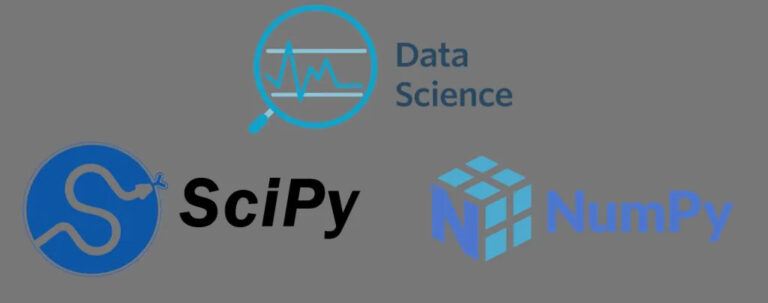The Python language is widely used in the field of Data Science. Its popularity is notably linked to its various libraries dedicated to data analysis, such as SciPy and Numpy.
What is SciPy?
SciPy (Scientific Python) is an open-source library dedicated to complex mathematical calculations or scientific problems. It was created in 2001 by Travis Oliphant, Pearu Peterson, and Eric Jones.
Native mathematical functions and libraries can be used in science and engineering to solve different types of problems.
There are also pre-installed algorithms for optimization, differential equations, integration, interpolation, algebraic equations, statistics and many other use cases.
SciPy is an extension of Nympy (Numerical Python), and therefore allows extremely fast and efficient data processing. This library is written in C, C++, Fortran, and Python.
The high-level commands and classes allow for easy data manipulation and visualization. In addition, SciPy can be integrated with many different environments and has a large collection of sub-packages for different scientific domains.

SciPy is used for Data Science and other engineering fields, as it contains the necessary optimized functions and acts as an extension of Numpy. This tool can be used to solve a wide variety of scientific problems.
What are the advantages of SciPy?
Thanks to a wide variety of sub-packages, SciPy overcomes the main obstacles of scientific computing. It is the most used scientific library behind the GNU Scientific Library in C/C++ or Matlab.
It is easy to understand and use and offers high performance in computing power. Furthermore, it operates on a NumPy library array.
Its database routines allow parallel programming. Finally, its open-source nature makes this tool particularly interesting.

SciPy and Machine Learning
Machine Learning engineers use SciPy for many use cases. This tool allows us to build and improve algorithms for Machine Learning development.
Its different modules allow algorithm optimization, integration, linear algebra, or signal processing. This is the main reason for its popularity in Machine Learning projects.
In addition, SciPy works with other tools like Matplotlib for data visualization. In general, all these tools work together to allow decision-makers to derive insights from data.
SciPy vs NumPy: what are the differences?
SciPy and NumPy are essential libraries, offering a wide range of functions or methods in Python. However, there are several differences between them.
In terms of functions, SciPy offers more detail. It can also perform complex operations like numerical algorithms and algebraic functions. Numpy, on the other hand, focuses more on sorting, indexing, and organizing.
The speed of calculation is faster with NumPy because it is based on the C language. SciPy, on the other hand, is written in Python and therefore delivers less speed but is more functional.
As a function-based library, SciPy does not exploit the concept of arrays. On the other hand, Numpy allows building multidimensional arrays of objects containing the same type of data.
How to learn how to use Python, Numpy, and SciPy?
The Python language and its libraries are essential tools for Machine Learning. To learn how to use them, you can choose DataScientest.
Python programming is part of our various Data Analyst, Data Scientist, and Data Management training courses. You will discover the fundamentals of Python, and the NumPy and Pandas libraries.
The other modules of our training courses cover Data Visualization, Machine Learning, databases, and Business Intelligence. At the end of the course, you will have all the skills required to become a Data Science professional.
At the end of the program, students receive a certificate issued by the Université Panthéon Sorbonne or MINES ParisTech / PSL Education in the framework of our partnerships. Among our alumni, 80% have found a job immediately after the training.
All of our training courses adopt a Blended Learning approach combining online learning on a coached platform and Masterclass. You can choose between a Continuing Education and an intensive BootCamp mode.










